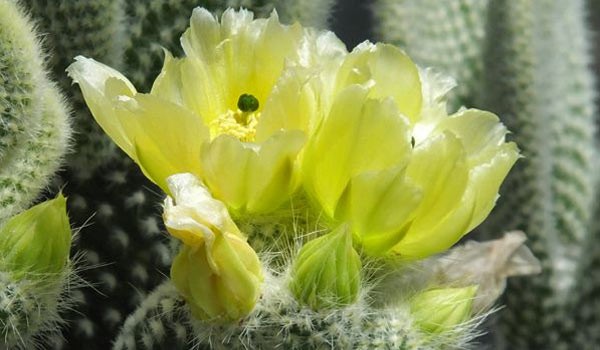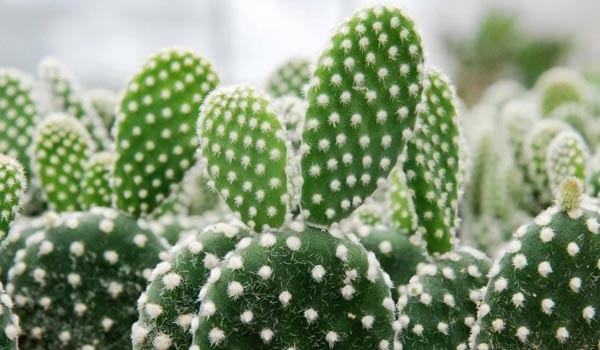Opuntia Microdasys (Bunny Ears Cactus) Care & Info

Although opuntia microdasys is not as fuzzy as its other names may suggest (such as bunny ears cactus), it is definitely a gorgeous succulent with the same minimum care requirements as other cacti.
Also known as angel’s wings, bunny ears cactus, and bunny cactus, and polka dot cactus, this easy-to-grow plant can grow in any place with enough bright light and average room temperature. And all you need to do is not to over-water your opuntia microdasys.
Opuntia Microdasys Origin & Look
With the botanical and scientific name of opuntia microdasys (op-UN-shee-a my-kro-DAS-is), the perennial bunny ears cactus is native to northern and central Mexico from the Cactaceae family. In deserts, bunny cactus grows in a shrub. When it is mature, it can cover between 2 to 5 feet (60 cm to 1.5 m) of ground with 18 to 30 inch (45 to 75 cm) height.
Angel’s wings cactus does not have a central stem; it simply has oval-shaped pads that shape its body. The young pads are red and turn to dark green as they grow. Because of their shape, and since they always grow in pairs, opuntia microdasys is commonly known as bunny ears cactus.
When the pads are fully grown, they will be covered with colonies of closely spaced yellow spines that are designed to come of easily with just a touch. If they found their way to your hand, it is best to use tweezers to remove them quickly as they can irritate the skin.
Opuntia Microdasys Flower & Fruit
In late spring, opuntia microdasys flower appear at the endpoints of fully grown pads with no needed encouragement. An in early summer, you can see them culminate with blossoms that are 2 inch wide. The cup-shaped flowers have a yellow color that turns peachy pink after fertilizing.
Each flower later turns to an opuntia microdasys fruit which is 2 inches (5 cm) long, and its color varies from purple to red. Both bunny ears cactus fruits and flowers are not toxic for pets; but as mentioned, the spines can irritate the skin.

Bunny Ears Cactus Care
The maintenance grade of polka dot cactus is actually medium, but having the below requirements in your mind, you can grow one anywhere in your house (since it is not cold hardy, and frost tolerant).
Pot & Soil
Similar to most cacti, opuntia microdasys varieties need to be potted in a container with many drainage holes. The soil should be well-drained, like sandy soil-bases or common pre-packaged cactus soils. For easier drain, you can also mix in a 1:1 ratio of perlite.
If you ever decided to repot your plant, do it in summer when the blooming is done. After repotting, water it regularly to promote the root system’s growth in the first year in the new container.
Light & Temperature
Bunny ears cactus requires full light as long as it is growing, which is most of the year. But in the winter cycle, you should reduce it to partial sun to ensure your plant’s health.
For best growth, you need to provide a temperature of 70 to 100 °F (21 to 37 °C) for bunny cactus. This needed temperature will decrease in its winter cycle. From the late fall, move your angel’s wings cacti to a spot with a temperature of 50 to 65 °F (10 to 18 °C) and away from heat sources for the entire winter.
During this time, the color of the pads changes from green to light gray. But you do not need to worry about it. What you should be concerned about, is not providing suitable conditions during the winter, which can, unfortunately, result in opuntia microdasys death the following spring.
- Tip #1: If you have decided to grow your opuntia microdasys outdoors, it will be okay in full to partial sun. A spot with 6 hours of sunlight a day is ideal. And if the winters where you live are colder than 20° F (-6.7° C), plant this specimen in a pot that you can be brought indoors.
- Tip #2: Also, make sure that you plant your polka dot cactus somewhere with plenty of room, as it can grow up to 6 feet (1.8 m) wide.
Water & Humidity
As we established, the bunny cactus is a desert species and should not be over-watered. However, in its first season in a new container, water it on a regular basis and keep the soil moist (not soggy) to strengthen its root system. After this time, you will need to water more occasionally.
During the winter cycle, do not water your bunny ears cactus at all. Start watering in the early spring, and every time the soil surface has dried.
In opuntia microdasys care, you need to provide low humidity conditions. You can run a dehumidifier in the room where you keep your angel’s wings to provide the needed humidity.
Fertilizing
You can feed your polka dot cactus with a low nitrogen fertilizer every month. Remember to stop a month before the winter cycle for its health.

Opuntia Microdasys Propagation
Similar to opuntia microdasys care, its propagation is fairly convenient as well. In the early summer, you can break off any fully grown pad easily and repot it. Do not forget to use gloves.
If the pads are grouped, use a clean and sharp knife to cut them instead of breaking them off. Also, remember to bury them 1 inch deep in the soil, and water regularly to encourage root system growth within the first year.
Bunny Cactus Common Problems
Opuntia microdasys varieties are usually pest-free, but there are some problems that can affect the decorative species; such as:
Overall, the polka dot cactus has slow growth. But sometimes you might realize that is it not growing at all (apart from winter cycles). This can indicate over-watering as well as under-watering. Correct the watering and wait to see the result. Over-watering can also lead to pad tips shriveling.
Some pests and insects can hurt your plant as well. For example, mealy bugs cause white patches on the pads. If you noticed brown patches, it can be the insects’ fault; but it can also indicate a drop in the temperature.
Stem base rot is another problem that solely happens to bunny ears cactus varieties due to excess watering. If this happened and your cacti began to die, break off mature pads for opuntia microdasys propagation.
- In this post:
- Opuntia Microdasys Origin & Look
- Bunny Ears Cactus Care
- Opuntia Microdasys Propagation
- Bunny Cactus Common Problems



